Computer Guided Dental Implant Surgery
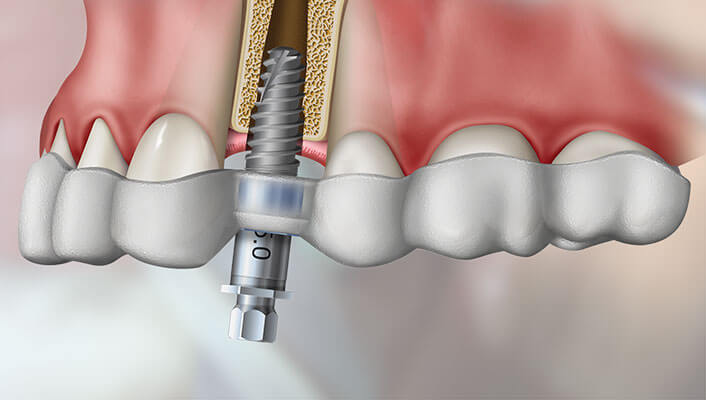
What Is Computer Guided Dental Implant Surgery?
Computer guided dental implant surgery is a specialized technique that employs advanced computer software and three-dimensional imaging to plan and execute the precise placement of dental implants within a patient’s jawbone. Unlike traditional methods, which rely heavily on the clinician’s judgment during the procedure, computer guided surgery offers a meticulous and personalized treatment plan based on the patient’s unique oral anatomy.
The process typically begins with the acquisition of high-resolution 3D scans of the patient’s jaw and surrounding structures using Cone Beam Computed Tomography (CBCT). The dentist can now analyze bone quality, available space, and the final aesthetic outcome. With this comprehensive understanding, the dentist can meticulously plan the entire implant procedure before even touching any surgical instruments.
During the surgery, the dentist utilizes a surgical guide, which is a customized template generated from the virtual model. The surgical guide acts as a precise roadmap, guiding the dentist to place the implants at the predetermined locations and angles with utmost accuracy. This level of precision not only ensures optimal implant stability but also minimizes trauma to surrounding tissues, resulting in reduced discomfort and a quicker recovery for the patient.
Computer guided dental implant surgery has become a game-changer for both dentists and patients alike, providing a faster, safer, and more comfortable dental implant process. Before you deciding on whether Computer Guided Dental Implant Surgery are right for you, there are some things you should know:
- Who Needs Computer Guided Dental Implant Surgery?
- What Are The Advantages Of Computer Guided Dental Implant Surgery?
- What Are The Potential Risks Or Complications Of Computer Guided Dental Implant Surgery?
- What Are The Alternative Treatments If I Do Not Choose Computer Guided Dental Implant Surgery?
- How Much Does Computer Guided Dental Implant Surgery Cost?
- What Are The Steps In The Computer Guided Dental Implant Surgery Procedure?
- Can I Have Computer Guided Dental Implant Surgery If I Am Pregnant?
If you have any further questions about Computer Guided Dental Implant Surgery or other dental services offered at Atlas Dental, please contact us.

Free phone consultation
Have questions about computer guided dental implants? Schedule a free phone consultation with our Toronto dentist.

5 star google reviews
Our patients love us! See for yourself why people are choosing Atlas Dental in Toronto for surgically guided dental implants.

Dental Implant Emergency service
Broke a tooth and need a dental implant? Book an emergency appointment today.
Who Needs Computer Guided Dental Implant Surgery?
Computer guided dental implant surgery is a highly versatile and beneficial approach to tooth replacement that can benefit a wide range of patients. While traditional dental implant techniques remain effective, computer guided surgery offers distinct advantages that make it particularly suitable for certain individuals. Here are some scenarios in which patients may greatly benefit from opting for computer guided dental implant surgery:
- Patients with Complex Cases: Individuals who have experienced significant bone loss or have complex dental anatomy can greatly benefit from computer guided implant surgery. The advanced CBCT 3D imaging and virtual planning enable the dentist to navigate challenging situations with precision, ensuring successful implant placement even in difficult scenarios.
- Patients with Multiple Missing Teeth: For patients who require multiple dental implants to replace several missing teeth, computer guided surgery becomes highly advantageous. The accurate placement of multiple implants is critical to achieving optimal functional and aesthetic results, and the computer-guided approach ensures proper alignment and distribution of implants.
- Patients with Limited Bone Volume: In cases where patients have experienced bone resorption or have naturally low bone density in their jaw, computer guided implant surgery becomes a vital tool. The precise planning allows for the identification of areas with the highest bone density, maximizing the chances of successful implant integration.
- Patients Seeking Minimally Invasive Procedures: Computer guided dental implant surgery minimizes the need for extensive incisions and reduces the manipulation of surrounding tissues. As a result, patients experience less trauma during the procedure, leading to faster healing and a more comfortable recovery.
- Patients with Dental Anxiety: Dental anxiety is common among patients, especially when undergoing surgical procedures. Computer guided surgery can be particularly appealing to such individuals as it offers a predictable and efficient process. The reduced chair time and increased precision can help alleviate anxiety and improve the overall patient experience.
- Patients Seeking Faster Treatment: Traditional dental implant procedures can involve multiple visits over an extended period. However, computer guided implant surgery streamlines the process by eliminating the need for trial-and-error adjustments during surgery. This saves time for both the dentist and the patient, resulting in a more time-efficient treatment.
- Patients with Specific Aesthetic Concerns: Achieving natural-looking aesthetics is a significant goal in dental implantology. With computer guided surgery, dentists can precisely plan the implant placement to ensure the most favorable aesthetic outcome, particularly in cases where front teeth or highly visible areas are being restored.
It is important to note that while computer guided dental implant surgery offers numerous advantages, not all patients may require or be eligible for this approach. The decision to opt for computer guided surgery is typically made collaboratively between the patient and the dental professional, considering the patient’s unique oral health needs, preferences, and the complexity of the case. If you have further questions about Computer Guided Dental Implant Surgery, please contact us.
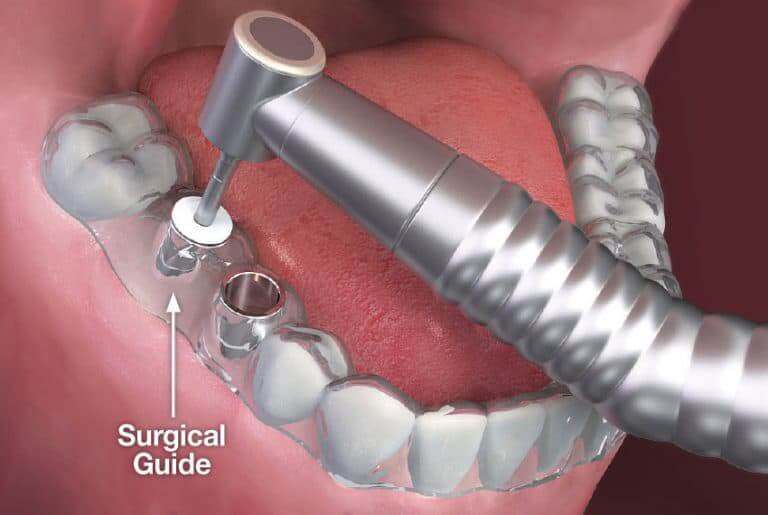
What Are The Advantages Of Computer Guided Dental Implant Surgery?
Computer guided dental implant surgery offers a plethora of advantages that make it a preferred choice for both dental professionals and patients. This revolutionary approach leverages cutting-edge technology to enhance the precision, safety, and overall success of dental implant procedures. Let’s explore the key advantages of computer guided dental implant surgery:
- Enhanced Precision and Accuracy: One of the most significant benefits of computer guided surgery is the unparalleled precision it provides. By utilizing advanced CBCT 3D imaging and virtual planning, dentists can map out the exact location, angle, and depth for each dental implant with exceptional accuracy. This precise placement minimizes the risk of errors, ensures proper alignment, and enhances the longevity of the dental implants.
- Personalized Treatment Planning: Each patient’s oral anatomy is unique, and computer guided implant surgery allows for highly personalized treatment planning. By analyzing detailed 3D scans of the patient’s jawbone and surrounding structures, the dentist can tailor the implant placement to fit the individual’s specific needs, maximizing the chances of successful implant integration.
- Minimally Invasive Procedure: Computer guided surgery significantly reduces the need for extensive incisions and manipulation of surrounding tissues. The use of a surgical guide ensures that the implants are placed with minimal disruption to the gums and bone, leading to less post-operative discomfort and faster healing.
- Predictable Outcomes: With traditional dental implant procedures, there can be some level of uncertainty regarding the final outcome. However, computer guided surgery eliminates much of this guesswork. Dentists can visualize the entire procedure beforehand, anticipate potential challenges, and plan accordingly, resulting in more predictable and favorable outcomes.
- Shorter Procedure Time: The meticulous planning involved in computer guided surgery streamlines the actual implant placement process. This leads to reduced chair time during the surgery, benefiting both the patient and the dental team. Shorter procedure times mean less time under anesthesia and reduced overall stress during the treatment.
- Improved Patient Safety: The comprehensive evaluation of the patient’s oral structures through 3D imaging allows dentists to identify potential complications or anatomical variations in advance. This early detection enhances patient safety by enabling the dental team to take necessary precautions and avoid any unforeseen issues during the surgery.
- Quicker Recovery Period: As computer guided surgery is less invasive and causes minimal trauma to the surrounding tissues, patients generally experience a quicker and smoother recovery. This translates to reduced post-operative discomfort and a faster return to normal daily activities.
- High Patient Satisfaction: Due to the precise planning, reduced risks, and improved aesthetic outcomes, patients often report higher satisfaction levels with computer guided dental implant surgery. Knowing that the procedure is backed by advanced technology and a detailed treatment plan instills confidence and peace of mind in patients.
- Cost-Effectiveness in the Long Run: While computer guided surgery may involve some initial investment in advanced technology, the benefits it offers can lead to long-term cost savings. Fewer complications, improved success rates, and reduced follow-up visits can contribute to overall cost-effectiveness in the patient’s dental implant journey.
Computer guided dental implant surgery represents a remarkable advancement in modern dentistry. By leveraging state-of-the-art technology, this innovative approach offers unparalleled precision, personalized treatment planning, and improved patient safety. Patients seeking dental implant solutions can confidently explore computer guided surgery as an excellent option for restoring their smiles with lasting results. If you have further questions about Computer Guided Dental Implant Surgery, please contact us.
What Are The Potential Risks Or Complications Of Computer Guided Dental Implant Surgery?
While computer guided dental implant surgery is generally considered safe and highly effective, like any medical procedure, it does carry some potential risks and complications. It is essential for patients to be aware of these factors and for dental professionals to take necessary precautions to minimize the likelihood of adverse outcomes. Below are some potential risks and complications associated with computer guided dental implant surgery:
- Inaccurate Imaging: The success of computer guided surgery heavily relies on the accuracy of the initial CBCT 3D imaging scans. If the images are not of high quality or if there are any technical issues during the scanning process, the surgical guide may not fit precisely, leading to inaccuracies during the dental implant placement.
- Surgical Guide Complications: The surgical guide, which is a key component of computer guided surgery, may occasionally cause complications. If the guide shifts or moves during the surgery, it could result in improperly positioned dental implants. Additionally, if the surgical guide is not properly fabricated, it may not fit the patient’s mouth correctly, leading to suboptimal outcomes.
- Nerve or Tissue Damage: Despite meticulous planning, there is a small risk of accidental damage to nerves, blood vessels, or surrounding tissues during the implant placement procedure. This risk is present in both traditional and computer guided implant surgeries and is generally minimized through the dentist’s expertise and careful technique.
- Implant Failure or Rejection: While computer guided surgery improves the accuracy of implant placement, the success of the dental implant still depends on factors such as osseointegration (the implant’s fusion with the jawbone) and the patient’s overall oral health. In rare cases, dental implants may fail to integrate properly or may be rejected by the body, requiring additional treatment or removal.
- Post-operative Infections: As with any surgical procedure, there is a risk of post-operative infections. Although the risk is relatively low, it is crucial for patients to follow their dentist’s post-surgical care instructions diligently to minimize the chances of infection and ensure proper healing.
- Temporary Discomfort: In the days following the surgery, patients may experience temporary discomfort, swelling, or bruising around the implant sites. These side effects are typically mild and subside as the healing process progresses.
It is important to note that while these potential risks exist, computer guided dental implant surgery is still considered a safe and highly successful technique with a proven track record. Dental professionals undergo extensive training to ensure proficiency in using the technology and conducting the procedure safely. As with any dental procedure, patients considering computer guided dental implant surgery should have a thorough discussion with their dentist or oral surgeon. If you have further questions about Computer Guided Dental Implant Surgery, please contact us.
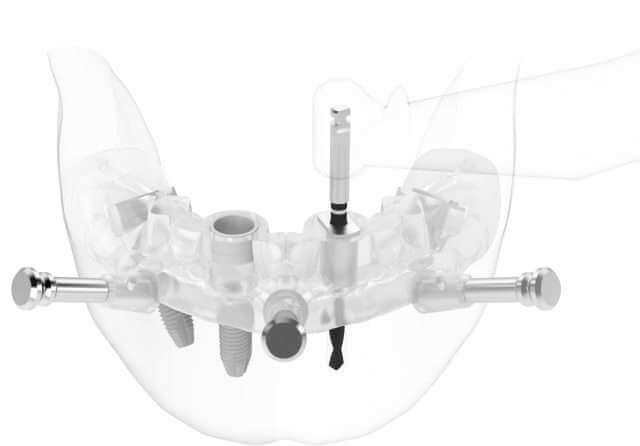
What Are The Alternative Treatments If I Do Not Choose Computer Guided Dental Implant Surgery?
While computer guided dental implant surgery presents numerous advantages, it may not be the preferred choice for every patient. Some individuals might opt for alternative treatments based on their specific dental needs, preferences, or other medical considerations. If you decide against computer guided dental implant surgery, several alternative treatments are available to restore missing teeth. Let’s explore some common alternatives:
- Traditional Dental Implant Surgery: The traditional dental implant procedure is a well-established and widely used approach for tooth replacement. Unlike computer guided surgery, the placement of dental implants in traditional surgery relies on the dentist’s judgment during the procedure rather than virtual planning. While it may not offer the same level of precision, traditional dental implant surgery remains highly successful in restoring missing teeth and providing long-lasting results.
- Fixed Dental Bridges: Fixed dental bridges are a non-surgical option for replacing missing teeth. A dental bridge consists of artificial teeth (pontics) that are anchored to the adjacent natural teeth or dental implants. This fixed restoration can effectively fill the gap left by missing teeth, restoring both function and aesthetics.
- Removable Dentures: Removable dentures are a more economical and non-invasive option for replacing missing teeth. These prosthetic appliances can be easily taken out for cleaning and maintenance. While dentures offer a practical solution, they may not provide the same stability and comfort as dental implants.
- Bone Grafting and Sinus Lifts: In some cases where patients lack sufficient bone density in the jaw, bone grafting or sinus lift procedures may be necessary to augment the bone before dental implant placement. These procedures can enable patients who were previously not eligible for dental implants to become candidates for traditional implant surgery.
- No Treatment: While not recommended, some individuals may choose not to undergo any tooth replacement treatment after losing teeth. However, leaving gaps in the dentition can lead to various oral health issues, including shifting of remaining teeth, jawbone deterioration, and difficulties with speech and eating.
It is essential to consult with an experienced dentist or oral surgeon to explore the most suitable tooth replacement option based on your specific oral health, bone structure, budget, and personal preferences. Your dental professional will conduct a thorough evaluation, discuss the pros and cons of each alternative, and help you make an informed decision that aligns with your oral health goals. If you have further questions about Computer Guided Dental Implant Surgery, please contact us.
Cost of Computer Guided Dental Implant Surgery
The cost of Computer guided dental implant surgery can range from $4828-5657.45, which includes the cost of a CBCT scan ($227-388.50 depending on the size of the scan), the cost of the surgical template (approximately $436), and the cost of dental implant surgery ($4155 to $5212 per site). The codes relevant to Computer guided dental implant surgery in the Ontario Dental Association’s Suggested Fee Guide appear as follows:
Radiographs, Cone Beam Computerized Tomography (CBCT), Acquisition
- 07011 – Small field of view (e.g. sextant or part of, isolated temporomandibular joint): $127
- 07012 – Large field of view (1 arch): $206.45
- 07013 – Large field of view (2 arches): $288.50
Radiographs, Cone Beam Computerized Tomography (CBCT), Interpretation
- 07032 – Two units (30 minutes): $100
TEMPLATE SURGICAL (includes diagnostic wax-up. Also used to locate and orient osseo-integrated implants)
- 03001 – Maxillary Template: $216 + Dental Lab Fee (approximately $220)
- 03002 – Mandibular Template: $216 + Dental Lab Fee (approximately $220)
Implants, Osseointegrated, Root Form, More than one component
- 79931 – Surgical Installation of Implant with Cover Screw – per implant: $1785+ Dental Materials Expense (approximately $350)
Alveolar Bone Preservation – Allograft
- 72421 – First tooth: $450 + Dental Materials Expense (approximately $300)
Crowns, Porcelain/Ceramic/Polymer Glass Fused to Metal
- 27215 – Crown, Porcelain/Ceramic/Polymer Glass Fused to Metal Base, Implant-Supported: $1280 + Dental Lab Fee and Dental Materials Expense (approximately $750)
The Ontario Dental Association’s Suggested Fee Guide is a proposed fee structure that dentists in Ontario may or may not follow. Please consult with your dentist about fees before going ahead with treatment.
Each dental implant surgery case is unique. Depending on your unique circumstance, implant surgery may be more difficult and more expensive if any of the following is required:
- CBCT scanning
- Computer guided implant surgery
- Immediate implant placement following tooth extraction
- Bone grafting to prevent bone loss
- Bone regeneration to grow new bone
- Simultaneous gum graft procedures
- Immediate tooth replacement at the time of surgery
- Sinus lifting procedures to raise the maxillary sinus floor
Computer guided dental Implant surgery is oftentimes considered a supplementary service by dental insurance plans and may or may not be covered by your dental insurance. Be sure to find out from your dental insurance plan provider how much you are eligible for before going ahead with dental treatment. Your dentist can help you submit a predetermination to your dental insurance.
For patients without dental insurance, Atlas Dental is pleased to offer dental financing through Dentalcard. Affordable payment plans start at 7.95% for terms of 6 months to 6 years. To learn more about Dentalcard dental treatment financing, follow this link.
What Are The Steps In The Computer Guided Dental Implant Surgery Procedure?
Computer guided dental implant surgery is a well-organized and precise process that involves several steps, each aimed at ensuring the successful and predictable placement of dental implants. This innovative procedure utilizes advanced technology to meticulously plan the surgery before the actual implantation takes place. Here are the typical steps involved in a computer guided dental implant surgery:
- Initial Consultation and Evaluation: The process begins with an initial consultation with the dental professional. During this appointment, the dentist or oral surgeon will conduct a comprehensive evaluation of your oral health, including examining the condition of your teeth, gums, and jawbone. 3D imaging scans, such as Cone Beam Computed Tomography (CBCT) or similar technology, may be taken to obtain detailed, high-resolution images of your jaw and surrounding structures.
- Creation of a Virtual Model: Using the 3D scans, a virtual model of your mouth is created. Advanced computer software is employed to analyze the data and generate a precise digital representation of your jawbone, gums, and existing teeth. This virtual model serves as the foundation for the planning and simulation of the dental implant procedure.
- Virtual Treatment Planning: The dentist or oral surgeon utilizes the virtual model to plan the dental implant surgery. They can virtually position the dental implants with precision, considering factors like bone density, available space, and optimal alignment. This stage allows the dental professional to anticipate potential challenges and tailor the treatment to your specific oral anatomy.
- Fabrication of Surgical Guide: Based on the virtual treatment plan, a surgical guide is fabricated. The surgical guide is a custom-made template that fits over your teeth and gums during the surgery. It has holes or sleeves at precise locations to guide the drills used for implant placement, ensuring accurate positioning of the implants as per the treatment plan.
- Preparation for Surgery: Before the surgery, the dental team will provide you with pre-operative instructions. This may include recommendations on fasting before the procedure, medications to take, or the need for a companion to drive you home after the surgery. Following these instructions is crucial for a successful and smooth surgery.
- Surgical Procedure: On the day of the surgery, the surgical guide is securely placed in your mouth. The dental professional follows the precise guidance provided by the surgical guide to make incisions at the predetermined locations and angles. Dental implants are then carefully inserted into the jawbone through these incisions.
- Healing Period: Your dentist will provide you with detailed post-operative instructions to follow. After the surgery, your body needs time to heal and for the dental implants to integrate with your jawbone (osseointegration). The duration of the healing period may vary from patient to patient, but it typically takes a few months.
- Final Restorations: Once the dental implants have fully integrated, the final restorations (such as dental crowns, bridges, or dentures) are crafted and securely attached to the implants. These restorations are customized to blend seamlessly with your natural teeth, providing functional and aesthetically pleasing results.
- Regular Follow-Up Visits: After the completion of the procedure, regular follow-up visits with your dental professional are essential. These visits allow them to monitor the healing process, assess the success of the implants, and ensure that your new smile remains in optimal condition.
Computer guided dental implant surgery has revolutionized the world of dental implantology, providing an advanced and patient-centric approach to restoring smiles with precision and efficiency. The process, guided by state-of-the-art technology and the expertise of dental professionals, ensures a more comfortable and successful dental implant journey for individuals seeking a long-lasting solution for missing teeth. If you have further questions about Computer Guided Dental Implant Surgery, please contact us.
Can I Have Computer Guided Dental Implant Surgery If I Am Pregnant?
If you are pregnant and considering dental implant surgery, it is essential to prioritize both your oral health and the well-being of your developing baby. Dental care during pregnancy is crucial, as hormonal changes and increased blood flow can lead to various oral health issues. However, the decision to undergo any dental procedure, including computer guided dental implant surgery, should be made after careful consideration and consultation with your healthcare providers. Here are some important points to consider regarding dental implant surgery during pregnancy:
- Safety Concerns: While computer guided dental implant surgery is generally safe, limited information exists on its specific effects during pregnancy. Due to the lack of comprehensive studies on the topic, dental professionals may err on the side of caution and postpone elective dental procedures, including dental implant surgery, until after the pregnancy.
- Trimester Consideration: The timing of the dental implant surgery during pregnancy is crucial. The second trimester is generally considered the safest period for non-emergency dental treatments. By this time, the risk of developmental complications is relatively lower, and you are likely to be more comfortable during the procedure.
- Local Anesthesia and Medications: Local anesthesia used during dental implant surgery is typically safe during pregnancy. However, the type and dosage of anesthesia used will be carefully selected to minimize any potential risks. The use of certain medications, including antibiotics and pain relievers, will also be considered with your pregnancy in mind.
- Stress and Anxiety: Dental procedures can cause stress and anxiety, which is not ideal during pregnancy. However, if the dental issue causing the need for dental implants poses a risk to your oral health or pregnancy, it may be necessary to proceed with the surgery after careful evaluation and with appropriate precautions.
- Radiographs and Radiation: Dental implant planning often involves the use of CBCT 3D imaging, which may expose you to minimal radiation. While the radiation levels are usually considered safe for adults, pregnant individuals should avoid unnecessary exposure to radiation during the first trimester. Your dental professional will take measures to minimize radiation exposure if imaging is necessary.
- Individual Consultation: Before proceeding with any dental procedure during pregnancy, it is crucial to have a detailed consultation with both your obstetrician and your dental professional. They will evaluate your specific medical history, stage of pregnancy, and the urgency of the dental treatment to determine the most appropriate course of action.
- Oral Health Maintenance: During pregnancy, maintaining good oral hygiene practices and attending regular dental check-ups are crucial. Preventive care can help address any minor dental issues early and avoid the need for more extensive dental procedures.
While computer guided dental implant surgery is a valuable advancement in dental implantology, pregnancy presents unique considerations that should not be overlooked. Your oral health and overall well-being, as well as that of your developing baby, should be prioritized. Before making any decisions about dental implant surgery during pregnancy, it is vital to have open discussions with both your obstetrician and dental professional to ensure the best possible outcome for you and your baby. If the dental issue can be managed conservatively during pregnancy, it may be advisable to postpone elective dental procedures, including dental implant surgery, until after delivery. If you have further questions about Computer Guided Dental Implant Surgery, please contact us.
We also think you’ll like…
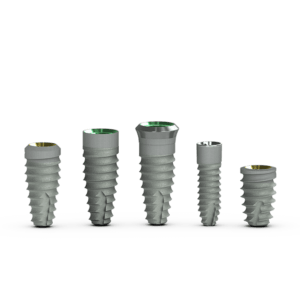
Camlog Dental Implants
Camlog Dental Implants What Are Camlog Dental Implants? Camlog is a reputable Swiss dental implant company that has earned recognition for its commitment to precision,
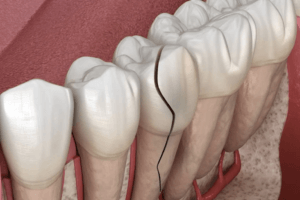
Crack Tooth Syndrome
Crack Tooth Syndrome What Is Crack Tooth Syndrome? Are you experiencing dental pain but your dentist has told you there is no obvious sign of
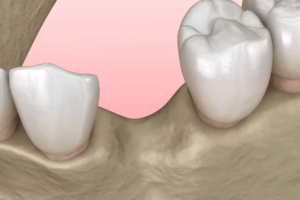
Dental Bone Loss
Dental Bone Loss What Is Dental Bone Loss? Dental bone loss, also known as periodontal bone loss or alveolar bone loss, refers to the loss
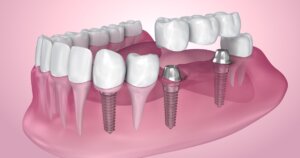
Dental Implant Surgery Informed Consent
Dental Implant Surgery Informed Consent I have been informed and afforded the time to fully understand the purpose and the nature of the implant surgery
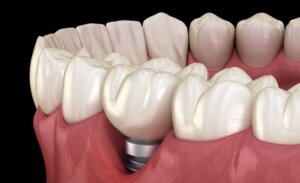
Dental Implant Failure
Dental Implant Failure What Is Dental Implant Failure? Dental implants are one of the most popular and effective solutions for replacing missing teeth. They are
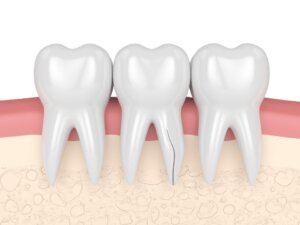
Vertical Root Fracture
Vertical Root Fracture What Is A Vertical Root Fracture? A Vertical Root Fracture is a kind of dental problem that’s quite challenging for dentists to

